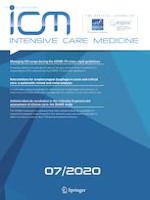01-07-2020 | Cardiopulmonary Resuscitation | Imaging in Intensive Care Medicine
Liquefactive necrosis of the brain
Published in: Intensive Care Medicine | Issue 7/2020
Login to get accessExcerpt
A 63-year-old woman remained in a prolonged comatose state following anoxic–ischemic injury after cardiopulmonary resuscitation. She was cared for at home by her family for 3 years, but was readmitted with acute on chronic hypercarbic and hypoxic respiratory failure, worsening pleural effusions, and a brief episode of pulseless electrical activity not requiring chest compression. On admission repeated neurologic examinations showed no awareness, no mouthing of words with a tracheostomy in situ, spontaneous eye drifts with a quick phase of nystagmus, not tracking nor fixating on objects or persons approaching the bedside. Winces were random and brief. There was severe spasticity, extensor posturing, hyperreflexia, and contractures. Her next of kin were convinced there was improvement and emotional connection. Now, MRI showed a residual scaffold of the brain due to global atrophy and cystic encephalomalacia with preponderance in the parietal-occipital watershed regions (Fig. 1). The pathophysiology is an intensive destructive process from ischemia by hydrolytic enzymes resulting in cavitation filled with liquid fluid. Cystification of the brain due to liquefactive necrosis and mineralization is rarely longitudinally imaged and a result of frequently instituted withdrawal of support when the initial neurologic and MRI findings are very worrisome. With such extensive loss of critical brain structures involving thalamocortical and subcortical circuitry, improvement is inconceivable.
Fig. 1
Upper row shows MRI images soon after cardiopulmonary resuscitation (T2 weighted images (a)). Diffusion weighted images (b, c) indicating diffuse cortical and basal ganglia brain injury. Lower row shows MRI images 3 years later with marked diffuse atrophy (d) cystic transformation of large parts of the brain (including the thalamus) with few discernable subcortical structures (e). The magnetic susceptibility image (f) indicates mineralization (mummification) and is imaged as black
× ![]()
…




